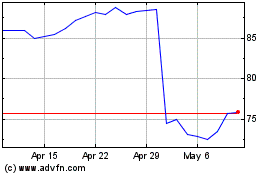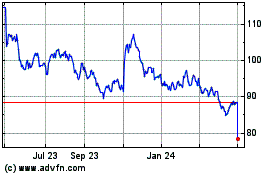No Turnaround in Sight for Starbucks -- Ahead of the Tape
January 25 2017 - 1:56PM
Dow Jones News
By Steven Russolillo
Between slowing growth and a management shake-up, it is no
wonder Starbucks Corp.'s stock is in need of a caffeine rush.
Shares fell 7.5% last year, their first annual drop since 2008
and only the sixth since Starbucks hit the public markets 25 years
ago. Missing sales targets in the U.S. -- its largest market -- for
four straight quarters will do that to a share price.
Adding more pressure was news late last year that Howard Schultz
will again relinquish the chief executive role, passing the torch
to Chief Operating Officer Kevin Johnson. The last time Mr. Schultz
stepped aside from the CEO role was during the lackluster stretch
from 2000 to 2008. The difference now is that he will remain with
the company as executive chairman but focus on high-end coffee bars
-- yet another attempt to change how Americans drink the
beverage.
But that venture won't be material to Starbucks's bottom line
soon, or perhaps ever. Meanwhile, there is little evidence ahead of
Thursday's fiscal first-quarter report to suggest Starbucks has
regained its mojo.
Analysts polled by FactSet forecast earnings for the period
ending in December of 52 cents a share, up from 46 cents a year
earlier. Revenue is expected to have risen 8.9% to $5.85 billion.
An important metric to watch is same-store sales, with analysts
projecting just 3.8% growth from a year earlier. That would be the
lowest since the financial crisis and far below the historic rate
of at least 5% that Starbucks is targeting.
Starbucks has noted how the presidential election and overall
economic uncertainty has played a role in its recent performance.
Or as Mr. Schultz put it at December's investor day: "the slight
slowdown in comps that has you all so nervous." Yet Starbucks is
struggling to peddle affordable luxuries despite numerous surveys
of consumer confidence surging to multiyear highs.
As Starbucks matures, finding new ways to keep growing is a
challenge. In December, it laid out aggressive five-year targets of
15%-20% earnings growth and double-digit revenue growth thanks to
more store openings and new digital initiatives. Membership is
growing on its mobile app, which helps its cafes operate more
efficiently. Mobile payments now make up 25% of U.S. transactions,
up from 20% in the year-ago period.
But shorter-term trends are working against Starbucks. Although
U.S. consumers say they are confident, they are spending their
money differently these days and eating out less. Foot traffic at
U.S. fast-food restaurants dropped 1% in the third quarter, the
first decline in five years, according to the most recent data from
industry tracker NPD Group. Starbucks isn't immune to this.
Fetching 26 times projected earnings over the next 12 months,
Starbucks is no bargain either. Its multiple is pricier than peers
Dunkin' Brands Group Inc., McDonald's Corp. and Yum Brands Inc.
Perhaps investors should stick to decaf.
Write to Steven Russolillo at steven.russolillo@wsj.com
(END) Dow Jones Newswires
January 25, 2017 13:41 ET (18:41 GMT)
Copyright (c) 2017 Dow Jones & Company, Inc.
Starbucks (NASDAQ:SBUX)
Historical Stock Chart
From Mar 2024 to Apr 2024

Starbucks (NASDAQ:SBUX)
Historical Stock Chart
From Apr 2023 to Apr 2024
